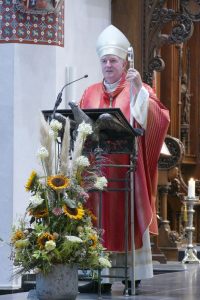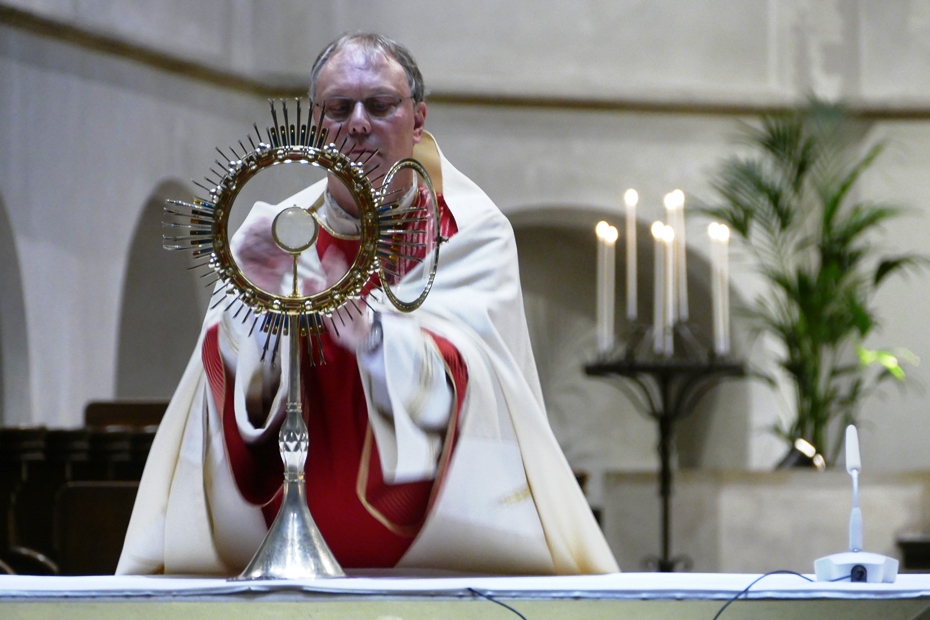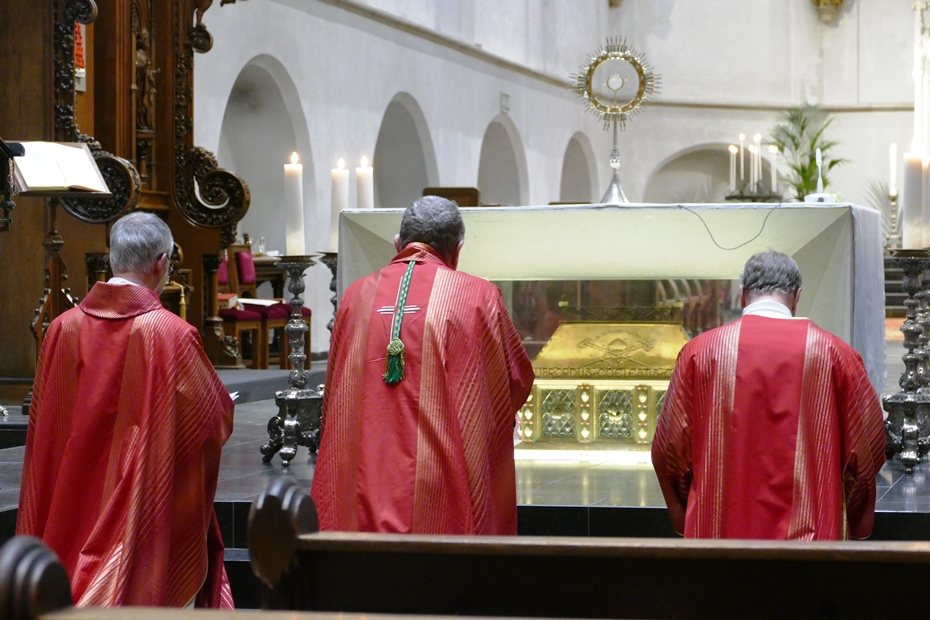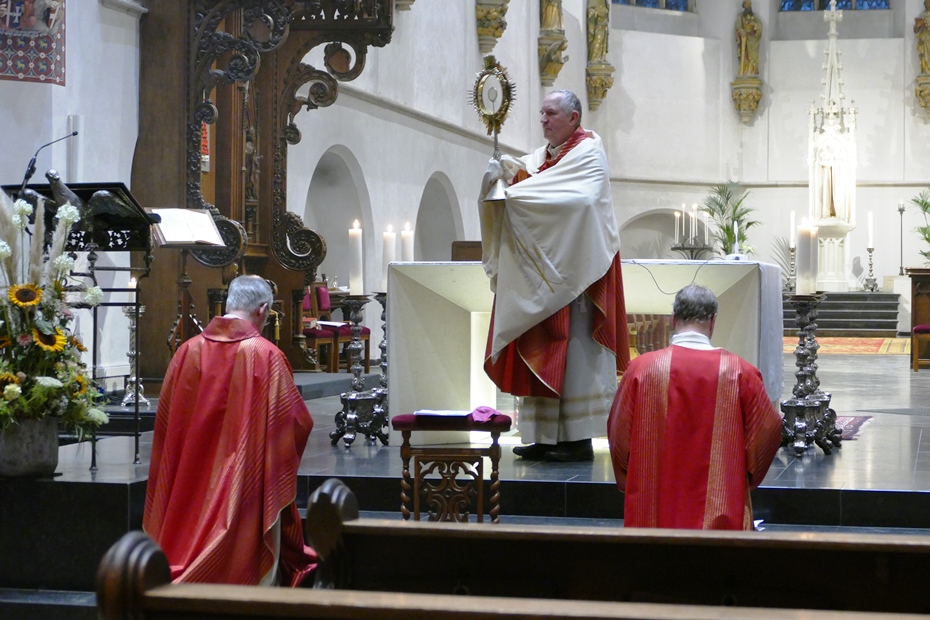15/09/2022
In de St. Catharinakathedraal te Utrecht werd op 14 september gebeden voor vrede in Oekraïne en heel Europa. Mgr. Hoogenboom was hoofdcelebrant tijdens de Mis, pastoor Boogers van de Utrechts St. Martinusparochie concelebreerde. Aansluitend was er stille aanbidding van het Heilig Sacrament. De viering was onderdeel van de dag van gebed voor de vrede waartoe de Raad van Europese Bisschoppenconferenties (CCEE) had opgeroepen.
Op 14 september viert de Kerk het feest van de Kruisverheffing, een feest dat op bijzonder plechtige wijze wordt gevierd in de Oosterse ritus. Alle Nederlandse bisdommen namen deel aan dit gebed, op die manier wil de Rooms-Katholieke Kerk in Europa haar nabijheid en solidariteit met de Oekraïners tot uitdrukking wil brengen. Zo werd gebeden: “Voor vrede en gerechtigheid in Oekraïne: dat partijen de weg van dialoog en onderhandelingen kiezen in plaats van oorlog en geweld, dat mensenrechten steeds gerespecteerd worden, burgers beschermd worden en slachtoffers worden opgevangen, dat met de stuwkracht van de Heilige Geest onvermoeibaar gewerkt wordt aan verzoening en samenwerking in Europa.”

Mgr. Hoogenboom stond in zijn preek stil bij het feest van Kruisverheffing: “Sinds de dagen van het Nieuwe Testament geldt het kruis als het teken van heil. Heel de aardse levensweg van de christen, van geboorte tot dood, staat onder het teken van het kruis. Het kruis is het christelijke symbool bij uitstek dat ondanks de secularisatie gelukkig nog op tal van plaatsen in onze samenleving zichtbaar aanwezig is. Het kruis is de samenvatting van de christelijke heilsboodschap. Tegelijkertijd moet worden gezegd dat het kruis als lijdenswerktuig ook een teken van tegenspraak is. Het staat midden in ons leven geplant als we geconfronteerd worden met ziekte en dood, als tegenslagen en teleurstellingen ons treffen, als het noodlot toeslaat.”
“We vieren het feest van Kruisverheffing in een tijdsgewricht waarin we getuigen zijn van onvoorstelbaar veel lijden en dood in onze wereld. In Oekraïne, maar ook op heel veel andere plaatsen. De oorlog in Oekraïne berokkent al meer dan een half jaar dagelijks onmetelijk leed aan talloos veel mensen en bedreigt de wereldvrede. In dit donkere uur, zo zei paus Franciscus eerder dit jaar, is de Kerk dringend geroepen om met voorbeden ten beste te spreken bij de Vredevorst. Ook moet de Kerk, de gemeenschap van gelovigen, haar nabijheid betuigen aan hen die rechtstreeks door het conflict getroffen worden.”
Door de tv-beelden die ons allemaal op het netvlies staan gegrift, worden we ook geconfronteerd met de vraag van het ‘waarom’ van al dit kwaad, zo merkte mgr. Hoogenboom op. Hij ging vervolgens in op de vraag hoe we dit kwaad moeten plaatsen: waarom laat God dit allemaal toe? “De sleutel tot het begrip van het mysterie van het kwaad ligt in het geloofsgeheim van het kruisoffer van onze Heer. God is in de regelrechte confrontatie met lijden en dood tot het uiterste gegaan,” aldus de Utrechtse hulpbisschop. “Het is de liefde die ons de sleutel geeft om Jezus’ kruisdood te verstaan. Op het feest van vandaag worden we uitgenodigd om op te zien naar Jezus op het kruis, om te zien hoe Hij in de school van het lijden gehoorzaamheid heeft geleerd.”



English
The St. Catharina cathedral in Utrecht prayed on the 14th of September for peace in Ukraine and Europe. Monsignor Hoogenboom was the head celebrant during the service, and pastor Boogers of the Utrecht Martinusparochie was his co-celebrant. Following the service, there was silent worship for the Holy Sacrament. The celebration was part of the Day of Prayers for Peace, which the Council of European BishopConference called fore.
On the 14th of September, the Church celebrated the Feast of the Cross. The Church performs this feast via a specific, solemn Eastern rite. Every Dutch dioceses took part in this prayer. This way, the Roman-Catholic European Church wants to express its proximity and solidarity with the Ukrainians.
The prayer: “For peace and justice in Ukraine: that parties away from the dialogue and negotiations choose instead of war and violence, for human rights to be respected, civilians to be protected and victims to be rescued, that with the thurst of the Holy Spirit it will work tirelessly to find reconciliation and collaboration in Europe.”
Monsignor Hoogenboom halted in his sermon to mention the Feast of the Cross; “Since the days of the New Testament, the sign of the Cross is seen as holy. The entire earthly way of life of Christians, from birth to death, is dedicated to the Cross. The Cross is the Christian symbol eminently, which is, despite secularization, still seen in many places in our society. The Cross is the summary of the Christian holy message. At the same time, it has to be said that the Cross, as an instrument of suffering, is a sign of contradiction. It is planted in the middle of our life when we are confronted with sickness and death when setbacks and disappointments hit us when fate strikes us.
“We are celebrating the Feast of the Cross in an age where we are witnessing imaginable suffering and death in our world. In Ukraine, but many other places too. The war in Ukraine has been bringing immeasurable suffering to countless people and threatening world peace for over six months. In this dark hour, as Pope Franciscus said earlier this year, the Church is urgently called to intercession in the best way with the Lord of Peace. The Church must also, the community of Christians, affirm their closeness to those directly affected by the conflict.”
All the TV images engraved on our retinas confront us with the ‘why’ of all this evil, Monsignor Hoogenboom noted. He then talked about how we should place this evil: ‘Why is God allowing this?’. “The key to understanding this mysterious evil is within the religious secret of the offer our Lord brought on the Cross. God accepted the confrontation with suffering and death and followed it until its extremity.” said the Utrechtse helping Bishop. “It is love which gives us the key to understanding Jezus’ death of the Cross, to see how He learned obedience from the school of suffering.”
Bron: St.-Chatharinakathedraal
